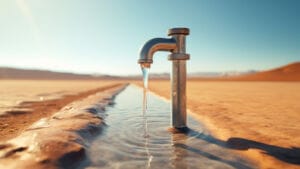Years into a record-breaking drought across the Southwest, officials of the seven states along the Colorado River finally forged an agreement in 2007 on how to deal with future water shortages. Then they quietly hoped that wet weather would return.
It didn’t.
Those states now are back at the negotiating table to hammer out new deals to avoid a slow-moving crisis on the river system that supports 40 million people from Colorado to California.
You can see the extent of the problem in a place like Page, on the southern edge of Lake Powell, the second-largest reservoir in the country behind Lake Mead.
Jennifer Pitt, who works on Colorado River policy for the National Audubon Society, stands on an overlook peering down at the lake and the immense concrete dam holding it in place.
“Now you can tell that there’s a river here underneath this reservoir because it has somewhat of a linear shape,” said Pitt, tracing the red rock canyon with her finger. “And it’s wending its way towards where we’re standing, here, overlooking the Glen Canyon Dam.”
The canyon behind the dam is stained with a stark white ring. For the past 20 years, Pitt said, demands for water have outstripped the supply, meaning Lake Powell and Lake Mead, behind Hoover Dam further downstream, continue to drop. Both are less than half full.
Without changes to how the two reservoirs are managed, Pitt said, levels could dip below the point where no water can be released, referred to as “dead pool.”
“If that happened, that would be a catastrophe for this region’s economy,” she said, “for all of the people who depend on the Colorado River and for all of the wildlife that depends on it as well.”
(The National Audubon Society receives funds from the Walton Family Foundation, which also provides funding for KUNC’s Colorado River coverage.)
It’s not about blame
That dystopian future of abandoned farms, dried-up streams and water-stressed cities is one that James Eklund of the Upper Colorado River Commission and other water managers are attempting to avoid.
“Take Lake Mead. More is being taken out than comes into it,” Eklund said. “Like your bank account, if you do that over a sustained period, you will run a deficit, and if you’re talking about water for 40 million people and economies that are massive – fifth-largest economy in the world, the Colorado River Basin represents – then that’s significant.”
Managers are attempting to boost reservoir levels with a suite of agreements under the umbrella of “drought contingency planning.” The premise is simple: Cut water use now, use that saved water to bump up Powell and Mead, and doing so will help to avoid bigger problems in the future, when supplies are likely to be even tighter.
Water officials in Colorado, Utah, New Mexico and Wyoming are working on a plan that covers the river’s Upper Basin and focuses on boosting snowpack with weather modification, better management of reservoirs and creating a water bank in Lake Powell.
The Lower Basin plan, being worked on by officials in Arizona, California and Nevada, is meant to create new incentives for farmers and cities to conserve water in Lake Mead and to agree to earlier, deeper cuts to water use so the reservoir can avoid dropping to dead pool levels.
Tuesday, water officials with all of the states, except Arizona, released draft agreements that spell out water cuts to boost levels at Mead and Powell according to azcentral.com. Arizona water officials plan to work through November to develop an agreement that state lawmakers would need to approve next spring.
“There is clearly enough evidence that if we were to have another 2000 to 2004 kind of a multiyear drought, the system is in very serious trouble,” said Eric Kuhn, the former general manager of the Colorado River District in Glenwood Springs, Colorado.
When the current management guidelines were written in 2007, planners were optimistic, Kuhn said.
“Historically, we’ve always said, ‘Well, next year will be better,’” Kuhn said. “And that’s the easy way out.”
Now, after another of the driest and hottest water years on record, much of that optimism has evaporated.
Kuhn said Arizona has had the hardest time coming to an agreement because of intrastate battles over who will take cuts to water allocations and when they’ll take them. But states in the river’s Upper Basin have had issues, too.
For example, with the concept of demand management.
“It’s the difficult one,” Kuhn noted. “Somebody’s going to have to use less.”
Kuhn said there’s a fear that if those cuts aren’t doled out fairly, it could injure economies throughout the Southwest. Colorado River District officials and Western Slope agricultural interests have said they’re on board with a demand management program only if farmers are given a choice about how much water they give up, and that they’re paid for forgoing water deliveries to their operations. But state officials have left the door open to mandatory cutbacks in a crisis.
Over the past three years, drought contingency negotiations have laid bare old tensions throughout the basin. Farmers and cities have blamed each other’s collective water uses for decades. Same with water managers protective of their own interests in either the Upper or Lower basins.
“The thing we have to remember is (water use) in the basin is over 80 percent agriculture,” said Colby Pellegrino, who handles Colorado River issues for the Southern Nevada Water Authority, the utility serving metro Las Vegas.
Current conservation programs, like the utility’s aggressive buyback of residential lawns, won’t be enough, Pellegrino said.
“We can take out all the lawns we want and still not solve the problems that climate change is going to throw at us,” Pellegrino said.
Climate change is just one pressure to get these deals done quickly. The U.S. Department of the Interior has given the Colorado Basin states an end-of-year deadline to get things done. If not, the assumption is the feds will step in to do it for them.
“That’s I think a fear of everybody on the river, especially in the Upper Basin,” said Jennifer Gimbel, a former Interior undersecretary, now with Colorado State University. “And the last thing we want is interference by the federal government in that role.”
The fate of the entire region hangs in the balance, said Gimbel.
At Glen Canyon Dam, Pitt, with the Audubon Society, said more than the fates of people and economies are tied up in river politics: An entire ecosystem is at stake.
“I think a lot of people who care about wildlife in this region are concerned,” Pitt said. “And it’s not just birds. Seventy percent of all wildlife in the arid West rely on rivers at some point in their life cycle. So it has outsize importance for anyone who appreciates nature in this part of the country.”




